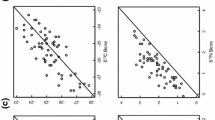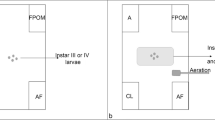Abstract
Analysis of resource partitioning between larvae of three Anisopteran species showed that Aeshna cyanea and Anax imperator (both Aeshnidae) tended to occupy similar ecological niches which were not shared by Libellula depressa (Libellulidae).
The diets of these predators and comparisons between trophic availability and diets indicated that prey species eaten varied according to season and predator species, and that some selection of prey species occurred.
Similar content being viewed by others
References
Aubertot, M., 1932. Les sacs peritrophiques d' Aeshna cyanea (Odonates — Anisopteres): leur évacuation périodiques. C. Scéanc. Soc. Biol. 111: 746–748.
Baker, R. L., 1980. Use of space in relation to feeding areas by zygopteran nymphs in captivity. Can. J. Zool. 58: 1060–1065.
Baker, R. L., 1982. Effects of food abondance on growth, survival and use of space by nymphs of Coenagrion resolutum (Zygoptera). Oikos 38: 47–51.
Benke, A., P. H. Crowley & D. M. Johnson, 1982. Interactions among coexisting larval Odonata: an in situ experiment using small enclosures. Hydrobiologia 94: 121–130.
Blois, C., 1983. Partage des ressources entre les larves de trois Anisopteres. Cas particulier: étude expérimentale du choix alimentaire chez Anax imperator. Thèse de 3° cycle: Univ. Rennes I.
Blois, C., 1985a. Diet variations according to developmental stage in three anisopteran species. Freshwater Biology in press.
Blois, C.,1985b. Répartition spatiale des larves de trois anisopteres. Odonatologica in press.
Blois, C., 1985c. Variations of predatory behaviour in Anax imperator larvae in relation to different prey types. Biol. Behav. in press.
Boerger, H., 1978. Life history and microhabitat distribution of midges (Diptera: Chironomidae) inhabiting a brownwater stream of Central Alberta, Canada. Ph.D. Thesis: Univ. Alberta Edmonton.
Chovet, M., 1976. L'alimentation de la larve de Cordulegaster boltoni (Donov. 1907) (Odonates: Anisoptères) dans son milieu naturel. Thèse de 3° cycle: Univ. Lyon.
Chutter, F. M., 1961. Certains aspects of the morphology and ecology of the nymphs of several species of Pseudagrion selys (Odonata). Arch. Hydrobiol. 57: 430–463.
Cloarec, A., 1977. Alimentation de larves d'Anax imperator Leach dans son milieu naturel (Anisoptera: Aeshnidae). Odonatologica 6: 227–243.
Crowley, P. H. & D. M. Johnson, 1982. Habitat and seasonality as niche axes in an Odonate community. Ecology 63: 1064–1077.
Folsom, T. C., 1980. Predation ecology and food limitation of the dragonfly Anax junius (Aeshnidae). Ph.D. Thesis: Univ. Toronto.
Giller, P. S. & S. McNeill, 1981. Predation strategies, resource partitioning and habitat selection in Notonecta (Hemiptera: Heteroptera). J. anim. Ecol. 50: 789–808.
Griffith, D., 1975. Prey availability and the food of predators. Ecology 56: 1209–1214
Johnson, D. M. & P. H. Crowley, 1980. Habitat and seasonal segregation among coexisting odonate larvae. Odonatologica 9: 297–308.
Johannsson, O. E., 1978. Co-existence of larval Zygoptera (Odonata) common to the norfolk Broads (U.K.). Oecologia 32: 303–321.
Kormondy, E. J. & J. L. Gower, 1965. Life history variations in an association of Odonata. Ecology 46: 882–886.
Lawton, H. H., 1970. A population study on larvae of the damselfly Pyrrhosoma nymphulea (Sulzer) (Odonata: Zygoptera). Hydrobiologia 36: 33–52.
Merrill, R. J. & D. M. Johnson, 1984. Dietary niche overlap and mutual predation among coexisting larval Anisoptera. Odonatologica 13: 387–406.
Pianka, E. R., 1973. The structure of lizard communities. Annu. Rev. Ecol. Syst. 4: 53–74.
Pritchard, G., 1964. The prey of dragonfly larvae (Odonata: Anisoptera) in ponds in Northern Alberta. Can. J. Zool. 42: 785–800.
Pritchard, G., 1965. Prey capture by dragonfly larvae (Odonata: Anisoptera). Can. J. Zool. 43: 271–289.
Pyke, G. H., A. R. Pulliam & E. L. Charnov, 1977. Optimal foraging: a selective review of theory and tests. Q. Rev. Biol. 52: 137–154.
Schoener, T. W., 1974. Resource partitioning in ecological communities. Science 185: 27–39.
Staddon, B. W. & D. Griffith, 1967. Some observations on the food of Aeshna juncea (L.) nymphs (Odonata) with particular reference to Corixidae (Hemiptera). Ent. mon. Mag. 103: 226–230
Thompson, D. J., 1978. The natural prey of larvae of damselfly. Freshwat. Biol. 8: 377–384.
Robert, P. A., 1958. Les Libellules (Odonates). Delachaux & Niestlé, S. A. Neuchatel, Paris, 345 p.
Vanderploeg, H. A. & D. Scavia, 1979. Calculation and use of selectivity coefficients of feeding: zooplankton grazing. Ecol. Model. 7: 135–149.
Author information
Authors and Affiliations
Rights and permissions
About this article
Cite this article
Blois, C. Diets and resource partitioning between larvae of three anisopteran species. Hydrobiologia 126, 221–227 (1985). https://doi.org/10.1007/BF00007499
Received:
Revised:
Accepted:
Issue Date:
DOI: https://doi.org/10.1007/BF00007499




